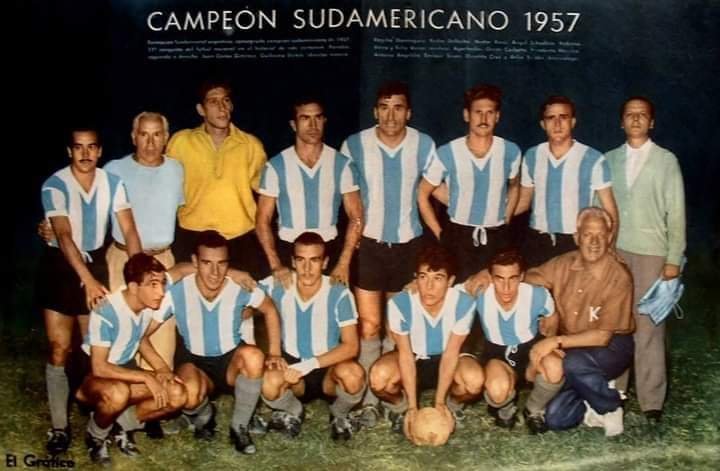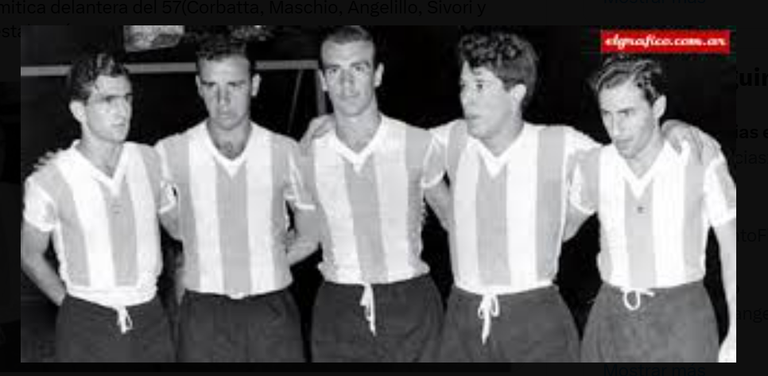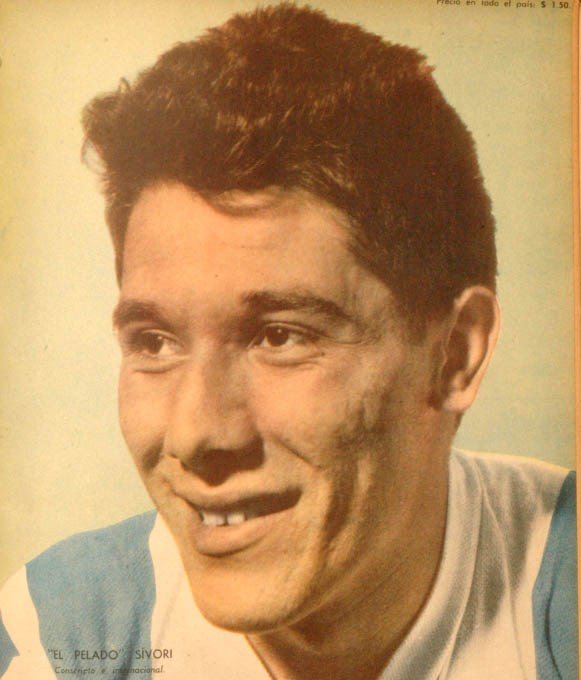Los carasucias (SPA-ENG)

En la década de 1950 las diferencias futbolísticas entre las principales selecciones de Sudamérica respecto al resto del subcontinente eran notables, muy distinto a lo que ocurre hoy en día donde si bien Brasil, Argentina y Uruguay continúan prevaleciendo ante el resto, esa desigualdad no es tan notable, incluso ha habido algunas sorpresas que antes parecían imposibles de acontecer.
En 1957 se disputó la 25va. edición del campeonato Sudamericano de selecciones nacionales, actualmente conocido como Copa América, la sede designada fue Perú y el torneo se disputó entre marzo y abril de aquel año.
Como en pocos ocasiones ocurre, ese año se alinearon los planetas para que Argentina presentara un conjunto joven pero lleno de talento, conformaron un equipo que no solamente deslumbró por su juego sino también por su actitud en la cancha pocas veces visto: alegres, atrevidos, ofensivos y letales; inmediatamente los llamaron "Los carasucias", un apodo que asemejaba a los integrantes del equipo con la apariencia de los jóvenes que por aquel entonces jugaban al fútbol en los potreros: libres, desacomplejados, llenos de barro y con el cuerpo sucio y desalineado, sin otro objetivo que el de divertirse practicando el deporte que amaban.

Argentina comenzó de manera notable su participación en ese torneo con una delantera extraordinaria conformada por Omar Corbatta, Humberto Maschio, Antonio Angelillo, Enrique Sívori y Osvaldo Cruz, ganaron 8 a 2 a Colombia en el primer encuentro.
Su marcha continuó de la mejor manera con un triunfo ante Ecuador por 3 a 0 y ante Uruguay por 4 a 0. Mientras tanto, Brasil no se quedaba atrás y ganaba por 7 a 1 ante Ecuador y 9 a 0 ante Colombia.
El torneo entraba en su fase final y los dos gigantes de Sudamérica se mostraban implacables, en el siguiente encuentro Argentina dio cuenta de Chile con un categórico 6 a 2 y Brasil perdió ante su némesis, Uruguay, por 3 a 2. La ventaja era de la albiceleste.

El partido entre ambos rivales históricos podía definir al campeón o llevar todo a una igualdad por definirse en la última fecha, no hubo reivindicación brasileña y Argentina se impuso por 3 a 0 consagrándose ganador de su 11vo. título sudamericano una fecha antes de la finalización del torneo.
Con el título asegurado, Argentina presentó un equipo suplente en la última jornada y se llevó su única derrota ante Perú, el local, por 2 a 1.
Ese equipo extraordinario que tuvo 6 jugadores en la selección ideal propuesta por la Confederación Sudamericana de Fútbol al finalizar el torneo demostró una superioridad aplastante con 25 goles en 6 encuentros, además tuvo al goleador del torneo, Maschio con 9 tantos y al segundo goleador Angelillo con 8.
Pero los problemas comenzaron, ese año hubo una diáspora de jugadores, quizás la primera muestra de que el fútbol europeo estaba dispuesto a llevarse a todos los grandes jugadores de Latinoamérica, Maschio, Angelillo y Sívori fueron vendidos a Italia. La reacción de la dictadura militar argentina no pudo ser peor, tildaron a los jugadores de traidores a la patria y los expulsaron de la selección nacional. A partir de ese momento se les conoció como "los exiliados del fútbol".

Al año siguiente, en el mundial de 1958 en Suecia, la selección argentina, diezmada por esas decisiones extra futbolísticas, fracasó rotundamente y Brasil en cambio obtuvo su primera copa Jules Rimet.
Los carasucias exiliados triunfaron en Europa, Maschio se nacionalizó y jugó para la selección italiana, Sívori triunfó en la Juventus consagrándose goleador en 1960-61 y ganando el balón de oro en 1961, Angelillo se nacionalizó italiano y fue ídolo en Inter consagrándose como goleador de la Serie A en 1958-59 con 33 goles, también él jugo en la selección Azzurra.

Maschio fue el único que volvió a jugar en la Argentina y no pudo irle mejor: campeón con Racing club de Avellaneda en 1966 y ganador de la Copa Libertadores de América y de la Intercontinental en 1967 venciendo al Celtic de Glasgow en una gran final que se resolvió en 3 partidos.
¿Qué hubiera pasado con la selección argentina en 1958 si no fuera por el capricho de un gobierno de facto que tomó la decisión de prohibir que 3 de los 5 integrantes de una delantera letal no pudieran jugar? es solo especulación, aunque mucho se ha hablado de ello y por supuesto de los carasucias que dejaron una huella imborrable.
The dirty faces
In the 1950s, the footballing gap between the top South American national teams and the rest of the subcontinent was notable, quite unlike today. While Brazil, Argentina, and Uruguay continue to dominate the rest, that inequality is not as striking. There have even been some upsets that previously seemed impossible.
In 1957, the 25th edition of the South American national team championship, now known as the Copa América, was held. The designated host was Peru, and the tournament was held between March and April of that year.
As rarely happens, the planets aligned for Argentina to field a young but talented squad that year. They assembled a team that not only dazzled with their play but also with their rarely seen attitude on the field: cheerful, daring, offensive, and lethal. They were immediately dubbed "Los carasucias" (Dirtyfaces). This nickname likened the team members to the appearance of the young people who played soccer in the fields at that time: free, uninhibited, covered in mud, and with dirty, disheveled bodies, with no other goal than to have fun playing the sport they loved.
Argentina got off to a remarkable start in that tournament with an extraordinary forward line comprised of Omar Corbatta, Humberto Maschio, Antonio Angelillo, Enrique Sívori, and Osvaldo Cruz, beating Colombia 8-2 in the first match.
Their run continued in the best possible way with a 3-0 victory over Ecuador and a 4-0 victory over Uruguay. Meanwhile, Brazil wasn't far behind, winning 7-1 against Ecuador and 9-0 against Colombia.
The tournament entered its final phase, and the two South American giants were unstoppable. In the next match, Argentina defeated Chile with a resounding 6-2 victory, and Brazil lost to its nemesis, Uruguay, 3-2. The advantage lay with the Argentines.
The match between these two historic rivals could have ended in a tie, as the final matchday would decide the champion. Brazil failed to rally, and Argentina won 3-0, claiming its 11th South American title one matchday before the tournament's end.
With the title secured, Argentina fielded a substitute team on the final matchday and suffered its only defeat against the host country, Peru, by 2-1.
That extraordinary team, which featured six players in the ideal national team proposed by the South American Football Confederation, demonstrated overwhelming superiority at the end of the tournament, scoring 25 goals in six matches. It also featured the tournament's top scorer, Maschio, with nine goals, and Angelillo, the second-highest scorer, with eight.
But problems began. That year, there was a diaspora of players, perhaps the first sign that European football was willing to take all the great players from Latin America. Maschio, Angelillo, and Sívori were sold to Italy. The reaction of the Argentine military dictatorship could not have been worse; they branded the players traitors and expelled them from the national team. From that moment on, they became known as "football's exiles."
The following year, at the 1958 World Cup in Sweden, the Argentine national team, decimated by these non-football decisions, failed miserably, and Brazil instead won its first Jules Rimet Cup.
The exiled dirty faces triumphed in Europe. Maschio became a naturalized citizen and played for the Italian national team. Sívori triumphed at Juventus, becoming a top scorer in 1960-61 and winning the Ballon d'Or in 1961. Angelillo became an Italian national and became an idol at Inter, becoming the top scorer in Serie A in 1958-59 with 33 goals. He also played for the Azzurri national team.
Maschio was the only one to return to Argentina, and things couldn't have gone better for him: he won the 1966 Copa Libertadores title with Racing Club de Avellaneda and the 1967 Intercontinental Cup, defeating Celtic in a grand final that ended in three matches.
What would have happened to the Argentine national team in 1958 if it weren't for the whim of a de facto government that decided to ban three of the five members of a lethal forward line from playing? It's only speculation, although much has been said about it, and of course about the dirty faces who left an indelible mark.
Héctor Gugliermo
@hosgug
Así llaman a una especie de loros en Venezuela
Pero no juegan al fútbol.
Jajaja, eso seguro 🤣
Que genial aprender con usted Héctor. Escuche sobre los carasucias, pero no conocía su origen y todo lo logrado. ¿Qué hubiera pasado? Una pregunta para reflexionar profundamente.
Abrazo.
¡Gracias Marcelo! @palabrasportss.
También un equipo de San Lorenzo de Almagro fue apodado con ese mismo apelativo unos años después, aunque los originales fueron estos.
Abrazo.
que gran historia, me encanta ver fotos antiguas acompañadas de una historia por detras. Vamos Argentina Carajoooooo!!!!!!!!!!!
Todos tenemos grandes historias @dobro2020 solo que para muchos pasan desapercibidas, la velocidad de la actualidad hace eso.
Es por ese motivo que los que tenemos más edad, cuando esa velocidad se retarda un poco, nos permitimos ver hacia atrás, de donde venimos, lo que dejamos y lo que nos hizo ser lo que somos en la actualidad.
Algunos nos atrevemos a contarlas y salen estas historias tan ricas y apasionantes.
Gracias por leer y comentar.
Qué pasaría con nuestras selecciones nacionales si aplicaran la misma fórmula para todos los miembros de los equipos que fueran a jugar a clubes europeos?
La verdad es que los tiempos nos muestran las características de cada momento.
Gracias por ilustrarnos con historias reales que no debemos olvidar.
Feliz jornada.
Salud y saludos.